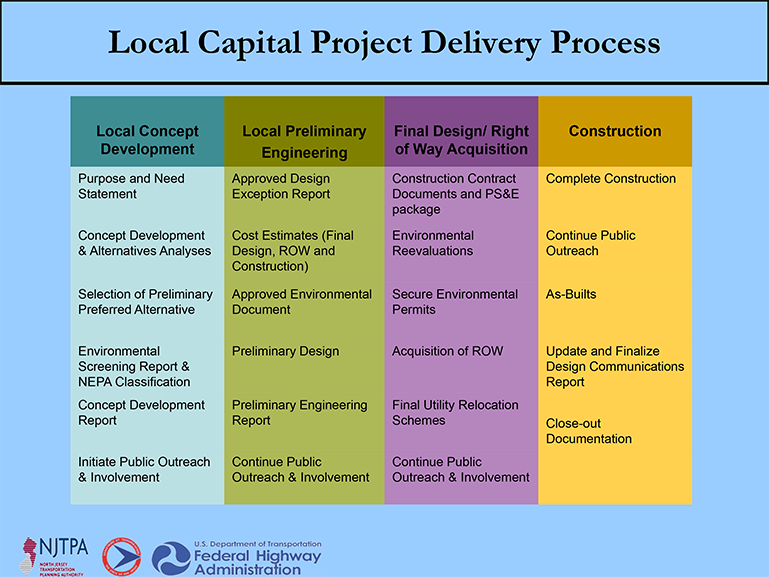
Project Overview
Bergen County and Essex County are advancing the design for the replacement of the existing Kingsland Avenue (Avondale and De Jessa Memorial) Bridge over the Passaic River to address its structural deficiencies and maintain an important transportation connection for local residents and regional commuters in Bergen County and Essex County. Due to its age, the bridge has deteriorated over time and routine maintenance can no longer address the deficiencies.
Overall Project Schedule by Phases
- Local Concept Development Study – completed Spring 2020
- Local Preliminary Engineering Phase – current, Summer 2022 – Spring 2024
- Final Design Phase – anticipated Summer 2024 – Summer 2026
- Construction Phase – anticipated Fall 2026 – Spring 2028
Local Concept Development Study Phase
A Local Concept Development (LCD) Study for major rehabilitation or replacement of the Kingsland Avenue Bridge was completed in 2020 using federal funding through the North Jersey Transportation Planning Authority (NJTPA), with Bergen County as the project sponsor and Essex County with shared jurisdiction. During this phase, a well-defined Purpose and Need Statement was developed focusing on the need to improve safety and maintain the current crossing over the Passaic River. A number of conceptual alternatives were developed to meet the project goals and objectives.
In coordination with the NJTPA, NJDOT, FHWA, local officials, community stakeholders, and permitting agencies, it was agreed, upon completion of an alternatives analysis, that the recommended Preliminary Preferred Alternative (PPA) to address the structural deficiencies is to replace the bridge with a new bridge structure. Resolutions of Support were passed by both the Township of Lyndhurst and Township of Nutley for the PPA. Improvements to the approach roadway intersections are also proposed in the vicinity of the bridge in Lyndhurst and in Nutley to better accommodate vehicular flow and mobility for pedestrians and bicyclists.
Local Preliminary Engineering Phase
The project is currently in the Local Preliminary Engineering (LPE) phase. The LPE phase involves performing engineering and environmental tasks and documentation in order to obtain National Environmental Policy Act (NEPA) clearance for the project. Based on the Preliminary Preferred Alternative (PPA), a number of activities are simultaneously set in motion: community involvement (meetings with affected property owners or business owners), agency consultation, environmental documentation, design level mapping and design services. To inform and to encourage community consensus, community stakeholder and public information center meetings will be conducted, which may lead to minor refinements of the approach roadway intersections of the PPA. The Townships of Lyndhurst and Nutley will be asked to maintain the resolutions of support for the PPA and for any design refinements.
The tasks conducted during the LPE Phase consist of, but are not limited to:
- Technical Environmental Studies (including Section 106 and Section 4(f) Evaluation)
- NEPA Document (Categorical Exclusion)
- Development of design level base plans
- Utility discovery and verification
- Geotechnical studies for foundation and pavement design
- Preliminary drainage work
- Structural studies that document the structural selection process and the recommended structure and aesthetic treatments
- Access and right of way impact evaluation
- Development of property acquisition cost estimates and project cost estimates
The LPE phase work began in August 2022 and will be completed by Spring 2024.
LPE Phase – Anticipated Project Schedule (Major Milestones)
| Environmental Documentation Completed | Fall 2023 |
| Submission of Local Preliminary Engineering Report | Fall 2023 |
| Completion of Local Preliminary Engineering Phase | Spring 2024 |
LPE Phase – Anticipated Community Involvement Schedule
| Local Officials Meetings | Fall 2022, Fall 2023/Winter 2024 |
| Community Stakeholders Meeting | Spring 2023 |
| Public Information Center Meeting | Fall 2023/Winter 2024 |
Final Design and Construction Phases
There are two more phases to the Local Capital Project Delivery Process using federal funding to replace the bridge. The duration of the subsequent Final Design and Construction phases is to be determined in the future.

Local Capital Project Delivery Process
Purpose & Need Statement
Data Collection & Environmental Screening Report
Selection of Preliminary Preferred Alternative
Concept Development Report
NEPA Classification
Create Design Communications Report
Initial Public Outreach & Involvement
Approved Design Exception Report
Cost Estimates (Final Design, ROW & Construction)
Approved Environmental Document
Approved Project Plan
Preliminary Engineering Report
Update Design Communications Report
Continued Public Outreach & Involvement
Construction Contract Documents & PS&E Package
Environmental Reevaluations
Environmental Permits
Acquisition of ROW
Update Design Communications Report
Continued Public Outreach & Involvement
Implement and Complete Construction
Continue Public Outreach
As-Builts
Update and Finalize Design Communications Report
Close-out Documentation
Recent News
Update: May 23, 2024
Meeting Report for Public Information Center (PIC) Meeting No. 1 is now available
Update: February 29, 2024
Thank you to those who were able to attend the Public Information Center (PIC) Meeting No. 1 for the Local Preliminary Engineering (LPE) phase.
Update: January 24, 2024
Save the Date: Online Public Information Center for the Local Preliminary Engineering (LPE) phase

